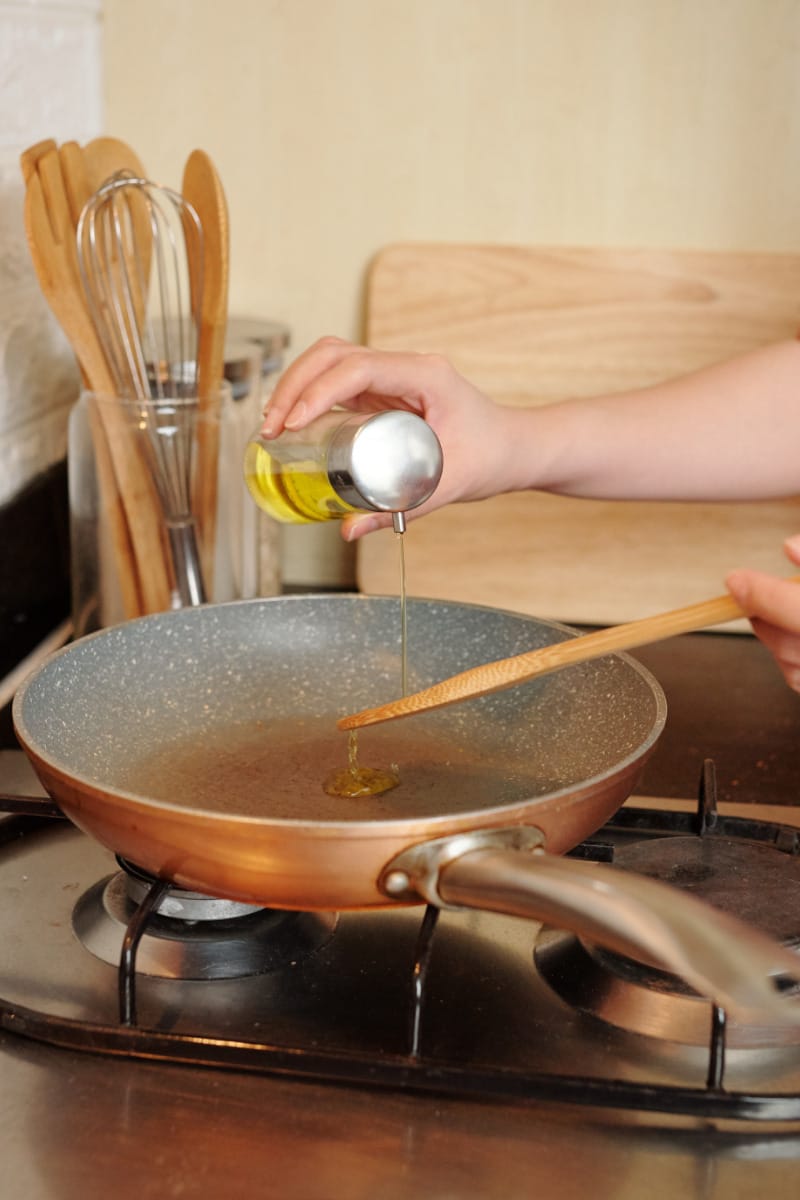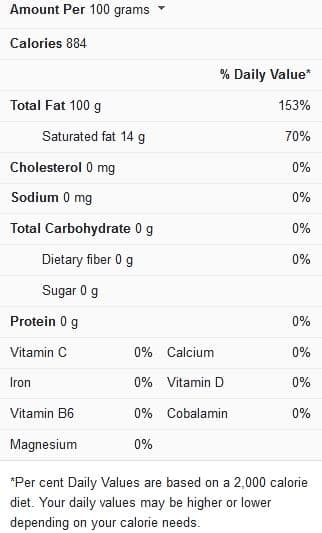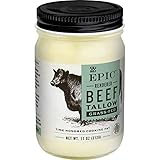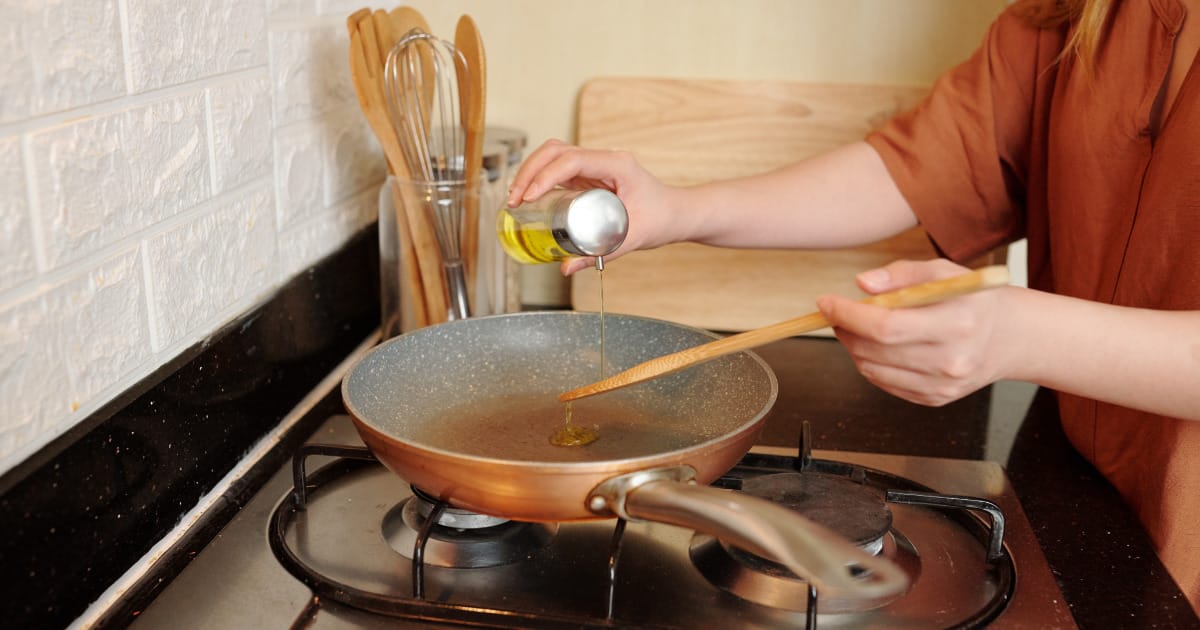Updated on October 17th, 2023
Some recipes would not even get started without oil. Whether you are deep frying, shallow frying, stir-frying, or even sautéing, it all starts with a splash or sprinkle of oil, and one of the best oils for pan-frying has to be a vegetable oil because of its high smoke point and mild flavor that is almost undetectable in many recipes.
Vegetable oil is one of those ingredients that you hardly notice in a dish, but its absence may be easily felt, so it is always good to stock up on some whenever you get the chance. But let’s say you are making a recipe that calls for some vegetable oil, but you discover you’re all out of this oil; what other oil can replace vegetable oil in your recipe?
In this article, I will be telling you the best healthy alternatives for vegetable oil in your recipes, but before we continue, let’s look at what vegetable oil is all about.

Vegetable Oil Nutrition Facts

What is Vegetable Oil?
Like animal-based oils, vegetable oil is a mixture of triglycerides. Still, unlike animal fats, vegetable oil is a fat extracted from the seeds or fruits of certain plants like canola, sunflower, cottonseed, soybean, or corn. The extraction of this fat can be carried out in several ways.
Plant-based oils have been in existence since the Bronze Age, when it was used by people in the Middle East, Central Asia, and Africa.
Uses of Vegetable Oil in Recipes
Vegetable oil is not usually the main ingredient in recipes, but whenever it is called for in a recipe, it is usually the first ingredient used. These oils have a very mild flavor that would go unnoticed in your recipe, so you don’t need to worry about an overpowering flavor.
Vegetable oil has a lot of culinary uses. Whenever you see it listed as an ingredient in a recipe, it is mainly to add texture to the final product, to add specific amounts of calories, or for shortening (to give pastries a crumbly texture).
Below are recipes that have vegetable oil listed as an ingredient.
- Mushroom Pork Chops with Spinach Skillet
- Asian Short Rib Nachos
- Goat’s Cheese Wonton Salad with Blueberry Dressing
- Korean Doughnuts with Salted Chocolate Sauce
- Fruit Mince Doughnuts
- Fish in Coconut Batter with Green Mango Salad
- Crisp Squid with Saffron and Green Apple Aioli
- Salt and Pepper Prawns with Pineapple Dipping Sauce
- Homestyle Fishcakes with Caper Tartare
- Fishcakes with Pea Crush
- Coconut Prawns with Mango Mayonnaise
- Onglet Steak with Salsa Verde and Parmesan Chips
- Barbecued Butterfield Lamb with Olive Oil Chips
- Pea and Haloumi Fritters
- Pasticcio Croquettes.
Substituting Vegetable Oil
As the days go by, we get to see more and more recipes that call for oil, these recipes have become increasingly popular, and one would think that the need for vegetable oil should rise with the increasing demand. But because vegetable oil contains unsaturated fats, which oxidize when heated, and many of these oils undergo a lot of processing during manufacture, these oils have been labeled “unhealthy” by various health experts.
This has prompted home chefs to look for a healthier alternative to vegetable oil (one which is low in unsaturated fats and one which does not require a lot of processing to extract oil).
Below are some examples of healthy oils that can substitute vegetable oil in your recipes.
Coconut oil
- NATURALLY NOURISHING COCONUT OIL FOR HAIR – With its unique combination of natural fats, coconut oil helps hydrate hair and nourish the scalp. It’s ideal for use as a conditioner, detangler, or coconut oil hair mask.
- HYDRATE NATURALLY WITH COCONUT OIL FOR SKIN – Coconut oil organic is a naturally moisturizing body oil that can help skin feel soft, smooth and hydrated. Use our coconut oil for face as a makeup remover—or even as a natural alternative to massage oils.
- COCONUT OIL FOR COOKING AND BAKING – An unrefined coconut oil with a naturally high smoke point (350°F), perfect cooking oil for baking, frying and sautéing. Our coconut oil is cold-pressed from fresh, organic coconuts, delivering a rich flavor and aroma
- A KITCHEN AND BEAUTY STAPLE – Whether you’re using our coconut oil for body moisturizer, as a coconut hair oil or as a cooking oil, it’s an all-natural, easy-to-use addition to any lifestyle. It’s a tastier alternative to cooking with olive oil or butter
- QUALITY YOU CAN TRUST – Our cold pressed coconut Oil is USDA-Certified Organic, Non-GMO Project Verified, Certified gluten free, Keto and Paleo, and grown and harvested organically without the use of harmful chemicals or additives
Just like the name suggests, coconut oil is extracted from coconuts. The good thing about this oil is that it is shallow in unsaturated fat, and the fact that it remains solid at room temperature means it is saturated fat.
This oil is pretty easy to get in any grocery store, and there is a high probability that you already have one in your kitchen.
Quickly swap in coconut oil for vegetable oil in any frying recipe using a 1 to 1 ratio, as it has a smoke point of 350°F.
Ghee
- 100% ORGANIC – If you are looking to use an authentic and 100% organic ghee oil option, then we have got you covered with our ghee from grass-fed cow’s milk that ensures you can lead an organic and healthy lifestyle. Our organic ghee also makes for an effective dietary addition as well as a suitable fit for paleo and keto dieting.
- MULTI-USE – We use ancient Indian wellness practice of Ayurveda to come up with this rich-tasting ghee butter spread that you can use for multiple purposes. Whether you would like to blend in your coffee, use for cooking your foods, frying, or spread on bread, it will serve your needs well. Its rich taste is rejuvenating and the unsalted butter will boost your energy levels.
- BOOSTS ENERGY, GUT HEALTH & IMMUNITY – Whether you are looking to get on with the day, reduce bad cholesterol intake, body inflammation, or improve your gut health, our Golden Monkey Clarified Butter has you covered with its lactose-free and gluten-free qualities that makes you healthier by boosting your immunity and helping to bulletproof you against illnesses.
- SOURCED IN BATCHES – To ensure that we live up to our promise of offering you a 100% organic unsalted butter option, we source all our grass-fed milk from 100% family owned farms across the USA. This helps us support our whole manufacturing process with authentic and organic products.
- SAFE & TASTY IN ALL FORMS: Ghee may be liquid, oily, gritty, buttery or can change from one form to another. All are safe to consume. For a buttery texture, melt and refrigerate for a few hours.
Ghee is similar to butter, but unlike butter, it is clarified. It contains almost 50% saturated fat, and one tablespoon of ghee (14grams) contains about 9g saturated fat, 4g monounsaturated fat, and 0.5G polyunsaturated fat making it a decently healthy alternative.
Use ghee as a direct replacement for vegetable oil in frying recipes.
Tallow
- BISON TALLOW: a staple cooking fat with endless limitations, just like your culinary imagination
- CONVENIENT: a go to, easy to grab ingredient to keep in your pantry
- VERSATILE: use in recipes such as pan seared meats, bison fat fries, and roasted sweet potatoes.
- HEALTHY COOKING FAT: Gluten-Free, Keto Friendly, Whole30 approved, Paleo friendly
- BOX CONTAINS: 11oz jar
Tallow is a solid fatty substance that is obtained from rendered animal fat. It was used in many fast foods for deep frying and another high heat frying until vegetable oil took the spotlight away from it in 1970.
Tallow is also a healthy fat, so feel free to replace vegetable oil with this animal fat in any frying recipe. It has a high smoke point that makes it suitable for high heat and low heat cooking.
Butter
- KERRYGOLD NATURALLY SOFTER PURE IRISH BUTTER: Made using only milk from summer grass-fed cows, the highest in naturally softer milkfat, and a gentle churning process, this butter is rich and spreadable.
- GENTLY CHURNED all-natural BUTTER: Kerrygold Naturally Softer Butter is unlike anything else in the world. Our golden, hormone-free butter adds richness to anything you spread it on, from bread to steak.
- KERRYGOLD BUTTER: Made from the milk of grass-fed cows, our pure Irish butter is rich and soft. From salted butter to unsalted, garlic and herb to reduced fat, Kerrygold butter elevates your dishes.
- MORE THAN BUTTER: Beloved for our richly flavorful butter, we put the same care and quality into our all-natural cheese, like our classic Dubliner, aged cheddar, Swiss, and Blarney Castle cheese.
- TASTE THE DIFFERENCE: Kerrygold butter & cheese are made with milk from grass-fed cows not treated with rBST or other growth hormones* & raised on Irish family dairy farms. This all-natural milk is what makes our products so flavorful & creamy.
I’m positive you have some butter at home. Why don’t you quickly switch from vegetable oil to butter? Butter would add a rich texture and flavor to your food, but keep in mind that butter has a low smoke point, and as such, it is only suitable for low heat frying.
Avocado oil
- One 33.8 fluid-ounce bottle of Avocado Oil
- Some of your favorite Amazon Fresh products are now part of the Amazon Grocery brand! Although packaging may vary during the transition, the ingredients and product remain the same. Thank you for your continued trust in our brands
- Neutral Flavor
- Non-GMO Project Verified
- Amazon Grocery has all the favorites you love for less. You’ll find everything you need for great-tasting meals in one shopping trip
Avocado oil is extracted from avocado pulps. It has a medium smoke point of about 271°c, which is safe for low heat frying. Although some avocado oils can withstand high temperatures without oxidizing.
The only downside to avocado oil is that it is more expensive than other oils on this list.
Frequently Asked Questions (FAQ)
Can I use extra virgin olive oil to deep fry chicken?
If your recipe involves a deep frying cooking method, extra virgin olive oil will do fine. Extra virgin olive oil has a decent smoke point which makes it suitable enough for high temperatures.
Why are these unhealthy oils so popular?
The reason why these “unsafe” oils are still manufactured and used by many restaurants is that it is a cheaper option than most saturated fat.
What is the shelf life of vegetable oil?
Unopened Vegetable oil can last for as long as one year in your pantry, and opened vegetable oil can also last up to one year in your fridge.
Conclusion
Vegetable oil is pretty easy and cheap to use; no wonder many restaurants use these types of oils. But if you are more concerned with what you eat, you may want to switch to a healthier alternative for your frying recipes, and luckily there are plenty of options for you to choose from.
Last update on 2025-06-30 / Affiliate links / Images from Amazon Product Advertising API





